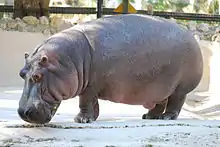Weyto caste
The Weyto, also referred to as Wäyto or Watta,[1] have been one of the Konso tribe that migrated to the northern Ethiopia, through time they have castes among the Amhara people of Africa.[2][3] Their endogamous strata has existed in the hierarchical Amhara society, one of the largest ethnic groups found in Ethiopia and neighboring regions.[4] Their hereditary occupation was hunting and leather work (tanning).[2]

The Weyto people are described in historical texts as a group of hippopotamus hunters in Ethiopia around Lake Tana, Lake Zwai and Bahir Dar.[1] Due to their diet on hippopotamus meat, the Weyto have been considered an outcast people and despised by Amhara and other ethnic groups.[6] Enrico Cerulli linked them to two other outcast groups of Ethiopia with similar names and live primarily as hunters: the Watta or Manjo of the Gibe region and former Kingdom of Kaffa; and the Watta amongst the Borana people.[7] Similar castes with hunting occupation live in other parts of the Horn of Africa, states Ephrem Tadesse, such as "the Watta among the Oromo, the Fuga or Mana among the Gurage, the Manjo among the Kaffa, the Kwegu among the Mursi/Bodi, the Hadicho among the Sidama, and the Mijan and Yibir among the Somali".[8]
The Weyto have been a small part of more elaborate Amhara caste system, ranked higher than slaves in its social stratification system. According to Donald N. Levine, an Ethiopian Studies specialist, the caste system depended on: endogamy; hierarchical status; restraints on commensality; pollution concepts; traditional occupation; inherited caste membership.[9] Scholars accept that there has been a rigid, endogamous and occupationally closed social stratification among Amhara and other Afro-Asiatic-speaking Ethiopian ethnic groups. However, some label it as an economically closed, endogamous class system or as occupational minorities,[10] whereas others such as the historian David Todd assert that this system can be unequivocally labelled as caste-based.[11][12][13]
The Weyto are reported to have once spoken a Weyto language, likely belonging to the Cushitic family.[1] The language became extinct at some point in the 19th century.[14] According to the 1994 national census, 1172 individuals were reported belonging to this ethnic group; it was not an ethnic choice in the 2007 census.[15]
The general term for hunter-gatherers in Ethiopia is Wayṭo/Woyṭo in Amharic (Uoïto in Italian records), Watta (pl. Watto) in Oromo, Fuga in the Gurage, and Manjō (Mangiò in Italian records) in Kafa. At least one group is reported to have called themselves Addō or Addoyē, though that may be the Oromo word for 'potters', another minority caste. Despite being lumped under common terms for hunter-gatherer, the Amharic-speaking Wayṭo of Lake Tana are a distinct people from the Kafa-speaking Manjō of the Keffa Zone, as well as from other Wayṭo/Watta/Fuga groups elsewhere in Ethiopia.
See also
References
- Matthias Brenzinger (1992). Language Death: Factual and Theoretical Explorations with Special Reference to East Africa. Walter de Gruyter. pp. 398–399. ISBN 978-3-11-087060-2.
- Donald N. Levine (10 December 2014). Greater Ethiopia: The Evolution of a Multiethnic Society. University of Chicago Press. pp. 195–196. ISBN 978-0-226-22967-6.
- Abebe Haile Gebremariam; Million Bekele; Andrew Ridgewell (2009). Small and Medium Forest Enterprises in Ethiopia. IIED. p. 4. ISBN 978-1-84369-720-6., Quote: "Well known castes include the fuga among the Gurage, the wato among the Oromo and the weyto among the Amhara."
- Central Statistical Agency, Ethiopia. "Table 5: Population Size of Regions by Nations/Nationalities (Ethnic Group) and Place of Residence: 2007" (PDF). Summary and Statistical Report of the 2007 Population and Housing Census Results. United Nations Population Fund. p. 84. Archived from the original (PDF) on 5 March 2009. Retrieved 29 October 2014.
- Kassam, Aneesa; Bashuna, Ali Balla (2004). "Marginalisation of the Waata Oromo Hunter–Gatherers". Africa. Cambridge University Press. 74 (02): 194–216. doi:10.3366/afr.2004.74.2.194.
- DH Koester (2013). A Backpacking Adventure In Ethiopia, Volume VIII. Africa Press. pp. 89–90. ISBN 978-1-4787-1016-5.
- Enrico Cerulli, "The folk-literature of the Galla of Southern Abyssinia", Harvard African Studies, 3 (1922), pp. 200-214
- Ephrem Tadesse (2015), Psychosocial and Educational Experiences of Students from Potter Family at Primary Schools, College of Education and Behavioral Studies, Addis Ababa University, page 9
- Donald N. Levine (2014). Greater Ethiopia: The Evolution of a Multiethnic Society. University of Chicago Press. pp. 56–57. ISBN 978-0-226-22967-6.
- Teshale Tibebu (1995). The Making of Modern Ethiopia: 1896-1974. The Red Sea Press. pp. 67–70. ISBN 978-1-56902-001-2.
- Todd, David M. (1977). "Caste in Africa?". Africa. Cambridge University Press. 47 (04): 398–412. doi:10.2307/1158345.
Dave Todd (1978), "The origins of outcastes in Ethiopia: reflections on an evolutionary theory", Abbay, Volume 9, pages 145-158 - Lewis, Herbert S. (2006). "Historical problems in Ethiopia and the Horn of Africa". Annals of the New York Academy of Sciences. Wiley-Blackwell. 96 (2): 504–511. doi:10.1111/j.1749-6632.1962.tb50145.x.
- Niall Finneran (2013). The Archaeology of Ethiopia. Routledge. pp. 14–15. ISBN 1-136-75552-7., Quote: "Ethiopia has, until fairly recently, been a rigid feudal society with finely grained perceptions of class and caste".
- Ethnologue Report for Weyto
- 1994 Population and Housing Census of Ethiopia: Results for Amhara Region, Vol. 1, part 1, Tables 2.10 (accessed 9 April 2009)
Bibliography
- Tal Tamari (1991). "The Development of Caste Systems in West Africa". The Journal of African History. Cambridge University Press. 32 (2): 221–250. doi:10.1017/s0021853700025718. JSTOR 182616.
- Eike Haberland (1993), Hierarchie und Kaste : zur Geschichte und politischen Struktur der Dizi in Südwest-Äthiopien, Stuttgart : Steiner, ISBN 978-3515055925 (in German)
- Todd, David M. (1977). "Caste in Africa?". Africa. Cambridge University Press. 47 (04): 398–412. doi:10.2307/1158345.
- Quirin, James (1979). "The Process of Caste Formation in Ethiopia: A Study of the Beta Israel (Felasha), 1270-1868". The International Journal of African Historical Studies. Boston University African Studies Center. 12 (2): 235. doi:10.2307/218834.
- I. M. Lewis (1998). The Peoples of the Horn of Africa: Somali, Afar and Saho. Oxford University Press. ISBN 978-1-56902-105-7.